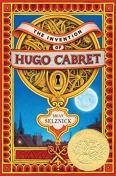BKMT READING GUIDES
The Invention of Hugo Cabret
by Brian Selznick
Hardcover : 533 pages
10 clubs reading this now
5 members have read this book
Introduction
Orphan, clock keeper, and thief, Hugo lives in the walls of a busy Paris train station, where his survival depends on secrets and anonymity. But when his world suddenly interlocks with an eccentric, bookish girl and a bitter old man who runs a toy booth in the station, Hugo's undercover life, and his most precious secret, are put in jeopardy. A cryptic drawing, a treasured notebook, a stolen key, a mechanical man, and a hidden message from Hugo's dead father form the backbone of this intricate, tender, and spellbinding mystery.
Editorial Review
Book Description:Orphan, clock keeper, and thief, Hugo lives in the walls of a busy Paris train station, where his survival depends on secrets and anonymity. But when his world suddenly interlocks with an eccentric, bookish girl and a bitter old man who runs a toy booth in the station, Hugo's undercover life, and his most precious secret, are put in jeopardy. A cryptic drawing, a treasured notebook, a stolen key, a mechanical man, and a hidden message from Hugo's dead father form the backbone of this intricate, tender, and spellbinding mystery.
Amazon.com Exclusive
| A Letter from Brian Selznick When I was a kid, two of my favorite books were by an amazing man named Remy Charlip. Fortunately and Thirteen fascinated me in part because, in both books, the very act of turning the pages plays a pivotal role in telling the story. Each turn reveals something new in a way that builds on the image on the previous page. Now that I’m an illustrator myself, I’ve often thought about this dramatic storytelling device and all of its creative possibilities. My new book, The Invention of Hugo Cabret, is a 550 page novel in words and pictures. But unlike most novels, the images in my new book don't just illustrate the story; they help tell it. I've used the lessons I learned from Remy Charlip and other masters of the picture book to create something that is not a exactly a novel, not quite a picture book, not really a graphic novel, or a flip book or a movie, but a combination of all these things. I began thinking about this book ten years ago after seeing some of the magical films of Georges Méliès, the father of science-fiction movies. But it wasn’t until I read a book called Edison's Eve: The Quest for Mechanical Life by Gaby Woods that my story began to come into focus. I discovered that Méliès had a collection of mechanical, wind-up figures (called automata) that were donated to a museum, but which were later destroyed and thrown away. Instantly, I imagined a boy discovering these broken, rusty machines in the garbage, stealing one and attempting to fix it. At that moment, Hugo Cabret was born. A few years ago, I had the honor of meeting Remy Charlip, and I'm proud to say that we've become friends. Last December he was asking me what I was working on, and as I was describing this book to him, I realized that Remy looks exactly like Georges Méliès. I excitedly asked him to pose as the character in my book, and fortunately, he said yes. So every time you see Méliès in The Invention of Hugo Cabret, the person you are really looking at is my dear friend Remy Charlip, who continues to inspire everyone who has the great pleasure of knowing him or seeing his work. Paris in the 1930's, a thief, a broken machine, a strange girl, a mean old man, and the secrets that tie them all together... Welcome to The Invention of Hugo Cabret. Yours, Brian Selznick |
Amazon.com Exclusive
|
--Brian Selznick |
More from Brian Selznick
|
|
|  The Boy of a Thousand Faces |
Discussion Questions
Suggested by Members
Book Club Recommendations
Recommended to book clubs by 2 of 3 members.
Book Club HQ to over 90,000+ book clubs and ready to welcome yours.
Get free weekly updates on top club picks, book giveaways, author events and more







 Dear readers,
Dear readers,  Brian Selznick on a "Deleted Scene" from The Invention of Hugo Cabret
Brian Selznick on a "Deleted Scene" from The Invention of Hugo Cabret


